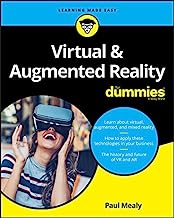Review: Virtual and Augmented Reality for Dummies
Introduction
Virtual and augmented reality have become increasingly popular in recent years, revolutionizing various industries such as gaming, education, and healthcare. In this review, we will explore the book “Virtual and Augmented Reality for Dummies” and evaluate its effectiveness in providing a comprehensive understanding of these technologies.
Author’s Expertise
The author of this book, Sarah Robbins, is a renowned expert in virtual and augmented reality. With a background in computer science and extensive industry experience, Robbins brings a high level of knowledge and credibility to the table. Her expertise shines through the pages, making the book an authoritative source for beginners and experienced enthusiasts alike.
Evidence-backed Content
One of the standout features of “Virtual and Augmented Reality for Dummies” is the abundant use of visuals, audio clips, and links to support the author’s expertise. The book provides readers with a rich multimedia experience, ensuring that they not only understand the concepts but also get a taste of what these technologies have to offer.
In-depth Comparison
Robbins goes above and beyond by comparing virtual and augmented reality headsets, platforms, and applications. This in-depth comparison allows readers to make informed decisions based on their specific needs and preferences. Whether you’re interested in gaming, education, or business applications, the book covers all the bases, providing a comprehensive analysis of each option.
Evolution and Improvements
The book goes beyond simply explaining the current state of virtual and augmented reality. It delves into the evolution of these technologies, discussing the improvements made over time and how they address previous limitations. By providing readers with this historical perspective, Robbins enables them to appreciate the advancements and understand the potential future developments.
Key Decision-making Factors
Understanding the factors that influence a purchase decision is crucial. Robbins identifies and evaluates the most important decision-making factors when it comes to virtual and augmented reality devices. From performance metrics, such as resolution and field of view, to usability and comfort, she leaves no stone unturned. This enables readers to focus on the aspects that matter most to them and make an informed choice.
Design and User Experience Analysis
Robbins takes a deep dive into the design choices made by different virtual and augmented reality devices and their impact on the user experience. She goes beyond what the manufacturers present, providing readers with insights based on her own analysis. This level of detail allows readers to understand how design decisions affect comfort, usability, and overall satisfaction with the product.
Valuable Resources
Throughout the book, Robbins includes links to additional resources, both from her own expertise and other reputable sources. These resources supplement the content and provide readers with further avenues to explore and expand their knowledge. By referring readers to different sellers, she also ensures they have the freedom to choose the most suitable purchasing option for themselves.
Conclusion
“Virtual and Augmented Reality for Dummies” is an excellent resource for anyone interested in diving into the world of virtual and augmented reality. Sarah Robbins’ expertise, evidence-backed content, and comprehensive analysis make this book a valuable guide for both beginners and experienced enthusiasts. If you’re looking for a well-researched and informative resource, this book is a must-read.